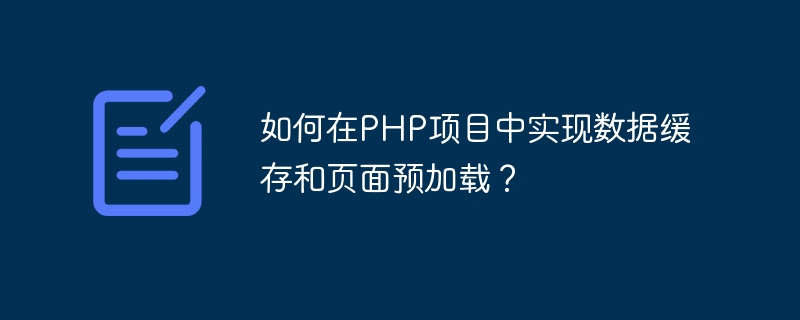Home >Backend Development >PHP Tutorial >How to implement data caching and page preloading in PHP project?
How to implement data caching and page preloading in PHP project?
- PHPzOriginal
- 2023-11-02 10:49:511279browse

How to implement data caching and page preloading in PHP projects?
With the development of the Internet, performance optimization of websites and applications has become an important issue. Among them, data caching and page preloading are one of the important means to increase user access speed and improve user experience. Implementing data caching and page preloading in PHP projects can effectively reduce database query and page rendering time and improve website response speed. This article will introduce the specific steps on how to implement data caching and page preloading in PHP projects.
1. Implementation of data caching
1. Choose the appropriate caching technology
To implement data caching in a PHP project, you can choose to use memory caching, file caching or remote caching and other technologies. Choose the appropriate caching technology based on your project's needs and performance requirements.
2. Set cache expiration time
When caching data, you need to set an appropriate cache expiration time. Expiration time can be determined based on the update frequency and importance of the data. Typically, static data can be set to a longer expiration time, while dynamic data needs to be set to a shorter expiration time.
3. Use caching strategy
In PHP projects, you can use caching strategies to determine whether you need to use caching. For example, you can determine whether there is already a cache based on the requested URL. If so, use the cached data directly. If not, perform a database query and cache the results. At the same time, time stamps and other methods can be used to determine whether the cache has expired, thereby determining whether the data needs to be re-cached.
4. Clean cache
While caching data, you need to consider the issue of cache cleaning. When data changes or expires, cached data needs to be cleared in time to ensure that users obtain the latest data.
2. Implementation of page preloading
1. Determine the pages that need to be preloaded
In PHP projects, you can determine the pages that need to be preloaded by analyzing the user's access path and behavior. page. Typically, frequently accessed pages can be preloaded to reduce user waiting time.
2. Set preloading priority
Setting the priority of preloading can be determined based on the importance and frequency of use of the page. You can use numbers or weights to represent priorities to ensure that important pages are loaded first.
3. Preload page content
During the process of preloading the page, you can use PHP file inclusion or HTTP request to load. By preloading page content, the required data can be obtained in advance and the page can be rendered, thus improving user access speed.
4. Use caching for page preloading
In the process of preloading the page, you can use data caching technology to cache the page content. By caching loaded pages, you can effectively reduce the time of repeated loading and improve user experience.
3. Summary
Implementing data caching and page preloading in PHP projects can significantly improve the response speed and user experience of the website. By choosing appropriate caching technology, setting a reasonable cache expiration time, using caching strategies and cleaning caches, the data caching function can be achieved. By determining the pages that need to be preloaded, setting the preloading priority, preloading the page content, and using cache for page preloading, the page preloading function can be achieved. To sum up, data caching and page preloading are important means to optimize the performance of PHP projects and are worthy of application and promotion in projects.
The above is the detailed content of How to implement data caching and page preloading in PHP project?. For more information, please follow other related articles on the PHP Chinese website!

